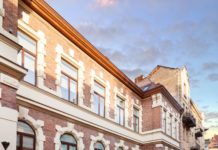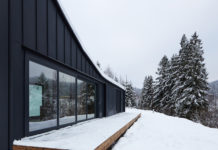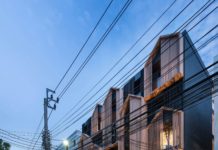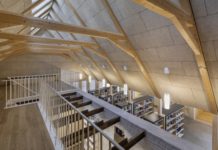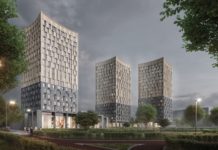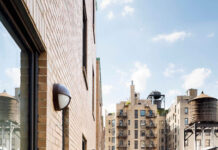Modern technologies allow to use fabric and in the architectural solutions. For example, in the Rhine-Westphalian technical University of Aachen (Rheinisch-Westfälische Technische Hochschule Aachen, RWTH abbreviated) conducted a comprehensive study of textiles and its potential in architectural design and construction. We talked with Ian Sarode, architect and research fellow at the Institute of textile technology, about the potential and prospects of textile facades.

Photo: architect Ian Serote explores the possibilities of textile facades
— Whether textile facades are a new invention?
— No, textile facades invented more than thirty years ago. There are various facade systems, which support the textile. Nevertheless, many architects have not yet revealed the potential of textiles for facades, in terms of design and sustainability.
— If textile facades have been thirty years, but little known, the question arises: how to recognize them?
— During the day the building of textile facades, sculpted look as the famous works of the artist Christo wrapping buildings. The window is usually hidden behind a fabric sheath, and at night the building glows from within, showing the outlines of the Windows on the facade.
— Except textiles outside dim of the room during the day?
— Fabric does not prevent solar rays and restricts the review. On the contrary, this front well diffuses direct light and creates a comfortable lighting. Textile barely noticeable from the inside. We work with ophthalmologists on the development of such fabrics that they do not interfere with the human eye. And in General, in their studies usually follow an interdisciplinary approach.
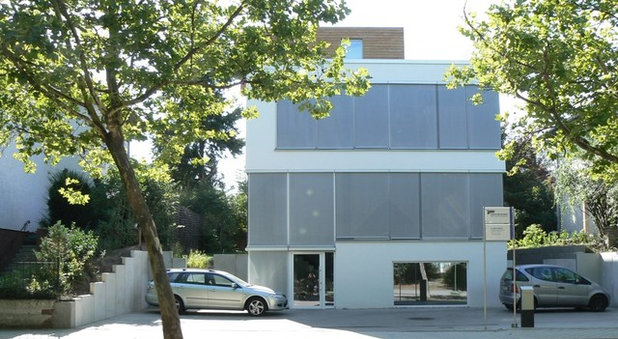
AW Architekturbüro GmbH
On the photo: for this project, in Magdeburg architectural Bureau AW hid behind the textile façade, large Windows and heterogeneous structures.
— What kind of fabric is made textile facades? They look like fabric for the construction of fences?
— Great difference between them: put scaffolding as temporary structures and textile facades should be set for a long time. It is a translucent facade made of polyester or fiberglass. Although polyester is cheaper and more suitable for printing on fabric, it is more susceptible to contamination and less durable (enough for 10-15 years). Fiberglass is more expensive and it will not print any bold print, but meets the higher requirements for fire protection, is stain-resistant and durable coating (serves to 40).
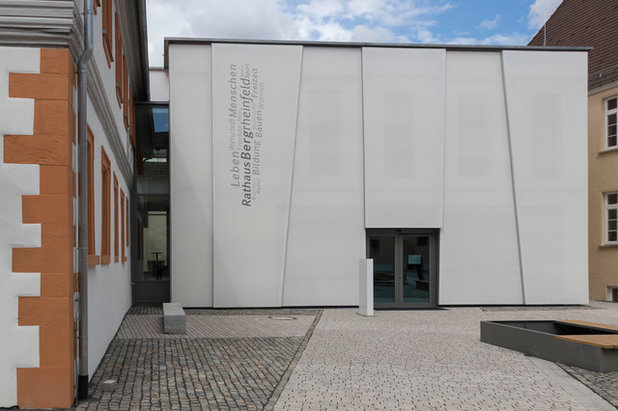
roho GmbH
On the photo: in the design of the extension of the town hall of the municipality of Bergrheinfeld textile facade roho GmbH printed slogans
— What happens at the end of life textile facade? Can you replace the material?
— Coating can be changed, and this is one of the advantages of textile facade. The frame structure attached to the building, and textiles, it can be easily replaced. Due to the nature of the material is not an absolute necessity: contamination can be removed with high pressure cleaning.
The ability to change the textile surface is a huge design potential which has revealed very slowly. With textiles countless possible solutions that make the design as flexible as the design of the interior.
— What happens to textile façade after the replacement? Can it be disposed of?
— This material is recyclable, it is 100% pure. However, until now it is little used in practice. We get reviews of many architects and designers, claiming that suitability for recycling plays a role when deciding about the installation of textile facade.
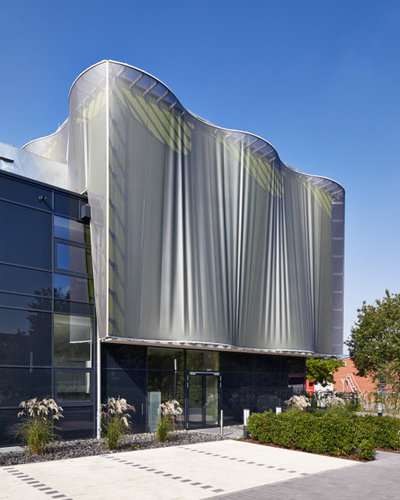
Photo: the facade of the new music school in Erftstadt planned to make a slight appearance, so the experts Graf Architekten joined the local brick with glass and textiles. Photo Of Philip Kistner
— Facades of textile fabric is always flat or there are options for three-dimensional, more three-dimensional solutions?
— There are different options. Textile facades are initially manufactured in rolls, but it is not necessary to set flush. The main advantage of the facade of the textile — good drapability. That is, facades can be done with surfaces of any complexity: a three-dimensional or complex organic. Decisive here are the location and form of metal, which stretched textiles.
— What are the basic requirements for textile façades?
— The most stringent requirement is fire safety, and then — resistance to weather changes. Whether the sun, wind, storm or hail, textiles should have high tensile strength.
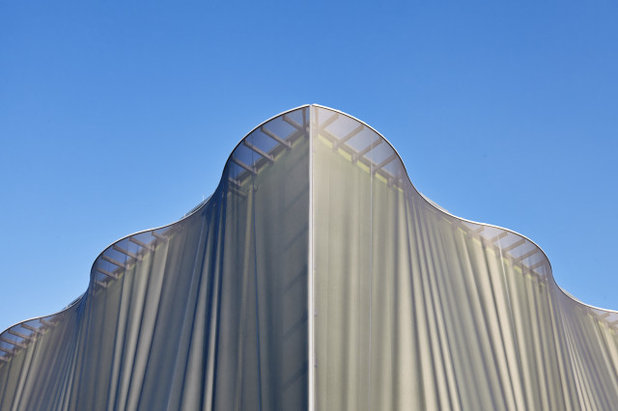
On photo: body textile façade of the music school in Erftstadt, Graf Architekten. Photo Of Philip Kistner
— Have there been any studies of the additional capabilities of textiles to the facades?
In our research group we are studying the innovation potential of textile facades, based on their sustainability. And continue to wonder what else you can do with these facades? How can they improve the quality of life in the future? Much depends on the possibilities of interdisciplinary cooperation. For example, now together with ophthalmologists, we are developing new structures to microtiny. Great attention in research is paid to the functions air purification, energy production using photovoltaic or solar thermal energy. Study the potential of media façades and adaptive façades.
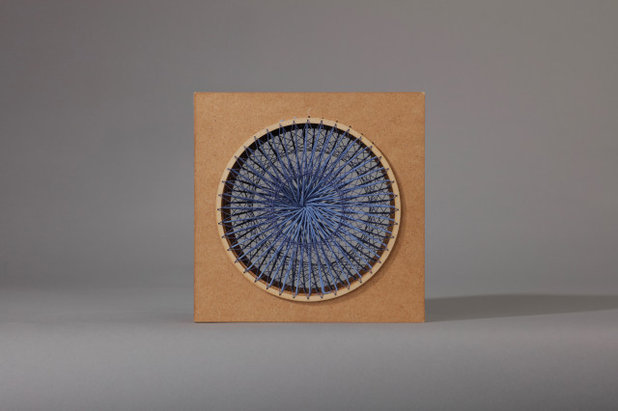
— What is adaptive facades?
— Automated sensor technology allows textile façades to change the transparency and breathability. The façade adapts to different climatic conditions with a single press of a button. This can be controlled individually via the app.
— Why are there so many forces concentrated on the climatic properties of the facades?
— Textile façade serves as a constructive protection from the sun. As a result, you save up to 78% of energy consumption for cooling buildings with air conditioning systems.
— How this cooling system through the textile façade?
— Energy-intensive heat of the sun, stopped a textile fabric, does not penetrate into the building. In addition, the distance between the textile facade and thermal facade, that is the actual wall of the building, creating the effect of a chimney. Warm air, which is formed behind and in front of a textile facade, rises.
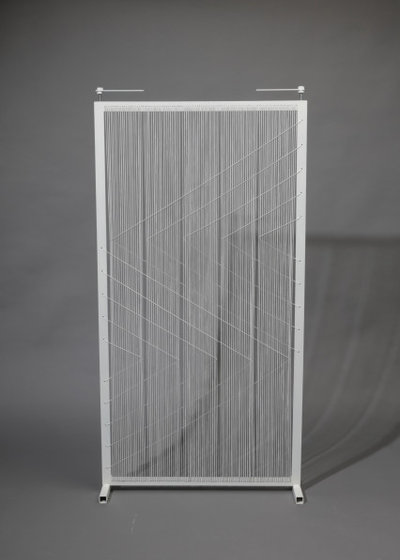
In the picture: a study of the properties of textile facades
Adaptive façades are adapted to the climatic conditions: for example, in winter, they allow direct sunlight to fall on the thermal shell of the building and Windows. We also conduct research in the field of solar cells and solar energy, which can be used to generate electricity and heat. Already developed a few prototypes.
— What about other problems, such as pollution? Is green facades are better suited for filtering pollutants from the air?
In our research we asked the question: what can the textile facades? Air purification is definitely one of their strengths. Together with an industrial partner we have developed a photocatalytic coating, with which the facade that filters and cleans the air. Wastes are relatively low and are washed away when it rains.
For example, this special textile facade coated with titanium dioxide. The coating filters out harmful nitrogen from the air and converts it into harmless nitrate in the process of photocatalytic treatment using oxygen from the air and sunlight. This waste is used as plant fertilizer. In the result, the textile façade improves the air and the outside and inside of the building.
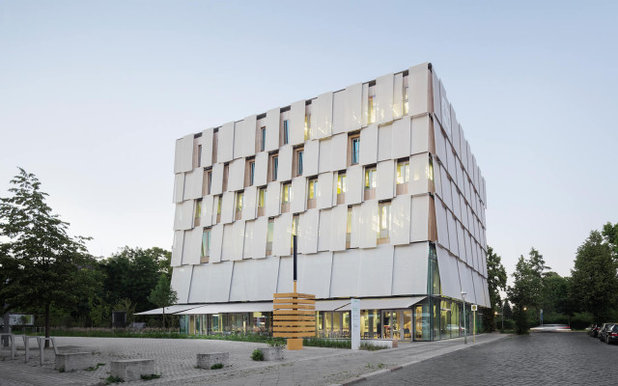
Photo: textile facade SOS children’s village (the centers for orphaned children), designed Ludloff Ludloff Architects. Photo Werner Huthmacher
— If textile facades are so good, why not pack in the fabric of all the buildings?
— Of course, our aim is great functionality of the building envelope. But the eyes better, when the urban landscape is formed of different styles and periods.
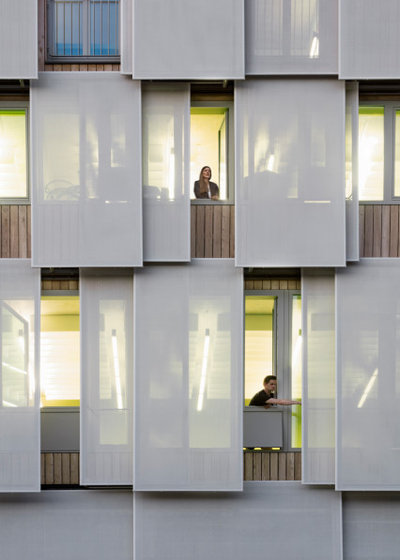
On the photo: detail of the facade of the building Ludloff Ludloff Architects, where textile elements can be easily moved, thereby changing the view window. Photo Werner Huthmacher
— How about small private houses? Whether they use textiles facades, or they are too expensive for this segment?
— Why not? Because other industrial materials have long been used for residential buildings. House, regardless of its form, can be fully enclosed in a textile façade that enriches and its appearance and functionality.
__________________________
IN YOUR CITY…
► Using Houzz, you can hire a designer or architect in any city and country. To start the search for a specialist
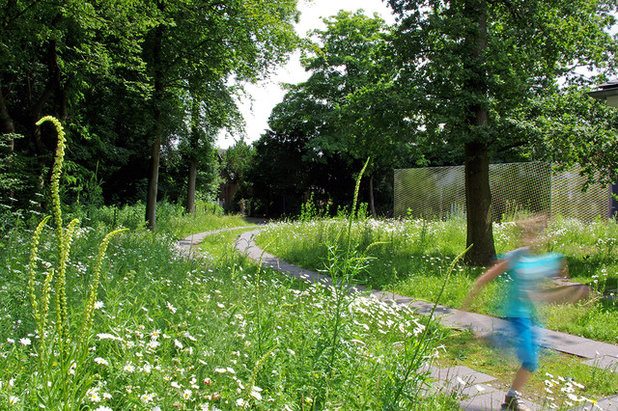
Riesop Landschaftsarchitektur GmbH
On the photo: in the garden designed Riesop Landschaftsarchitektur, for textile façade hidden garage. At least summer is an office building barely noticeable
For installation of textile facade needs a special metal structure which carries the material. The Assembly of this design accounts for about 27% of the costs, the textile — only 25%. There are also large companies such as Roho or Schüco, from manufacturing and construction, and textiles for them.
____________________________
ON THE SUBJECT…
- Architecture: home Printing on a 3D printer is a reality?
- The future is ours and architecture: what is it?
- Why do you need: Glass facades


